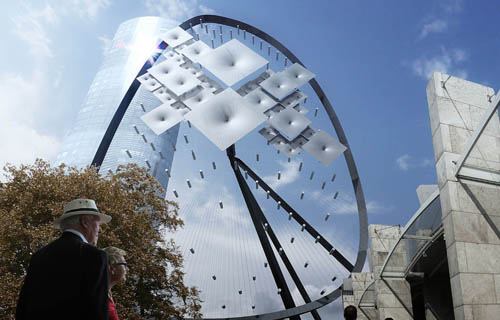I love the idea of the 400-foot tall, free-standing sun shade New York-based firms REX and FRONT have proposed to dampen the reflections off the Museum Tower that are frying the art and the grass at the Nasher Sculpture Center in Dallas. I have no idea if the proposal is at all feasible. But, making a beautiful object that would be an addition to the city as a response to a malfunction in urban relations seems like a much better idea than compromising the integrity of either the tower or the museum.
The problem, as I—and countless other critics and observers—have noted before is that the Johnson Fain-designed Tower’s curvature and skin work in a nefarious manner together to reflect a “death ray” down into the adjacent Nasher. I have also noted that I do not believe that the Nasher, designed by Genoa, Italy-based Renzo Piano Workshop, is one of the world’s greatest buildings, but it is rather a problem to not be able to put works of art on view because of the influx of light. It is also a problem to retrofit the Tower without spending a vast amount of money and probably reducing its not inconsiderable elegance, not to mention the views from the pricey apartments.
Now the architects and “consultants” of REX and FRONT (an interdisciplinary, new-style client rep/construction administration group) have come to the rescue with their proposal of a “shade” mounted in a bicycle wheel as big as a building, with an array of individual scrims that would track the sun and unfold to block the rays reflecting off the Tower. In one swoop, not only would the problem go away, but a sculpture would bring out the relationship between these structures while making us aware of the movement of the sun in an otherwise completely human-made environment.
It might not work. It might not be feasible. The supports for such a structure would have to be immense and would take up a great deal of space. The whole thing would be very expensive. But if you could solve those glaring problems, and if it was cheaper than the fix to the Tower, then it would add a work of great beauty to a city core that has some decent Late Modern and Post Modern boxes, and one very nice Turbo Modern one (the OMA- and REX-designed Wyly Theater), but not much else to distinguish it. It would join the hovering globe of the Reunion Tower at the other edge of downtown as a civic marker, but this would be one that would celebrate the sun that bakes Texas, the State’s bravura in both scale and technology, and its ability to solve problems in a big way.
There is a bigger point here, I think. As our cities fill up and spread out, we need to weave them back together again and make them manageable—something less than buildings and more than trees, benches, and signs. We need a civic version of Jane Jacob’s celebrated front stoop, but also a modern equivalent of the monuments, fountains, and other civic symbols and amenities that gave character to our cities. We need something to tie us together and to our landscape, something that reminds us where we are, and where we are going. Shade might be a good and bold place to start.
